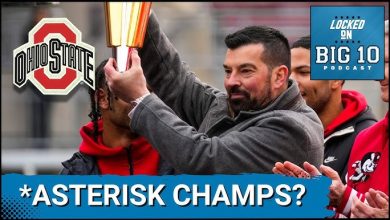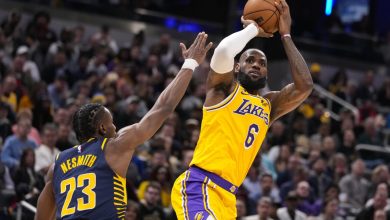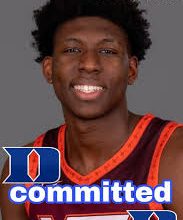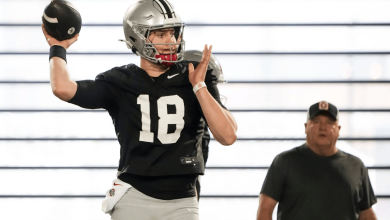Texas Longhorns offensive lineman Kelvin Banks Jr. receives one of his lowest mock draft placements to date.
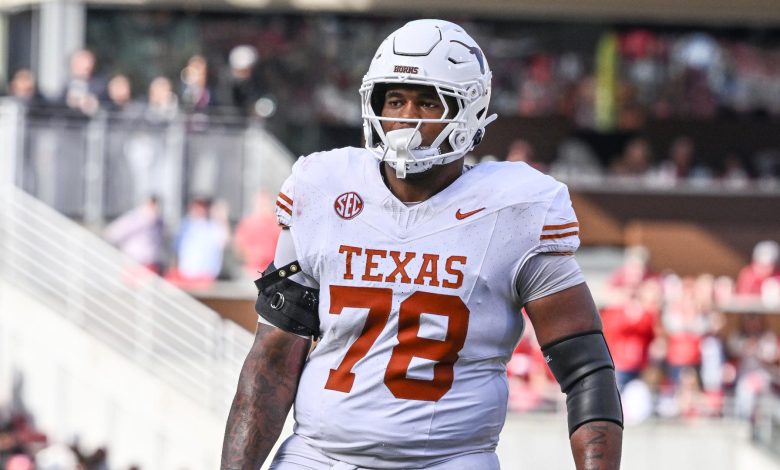
Texas Longhorns Offensive Lineman Kelvin Banks Jr. Receives One of His Lowest Mock Draft Placements to Date
As the NFL draft approaches, all eyes are on the top prospects from across the country. For Texas Longhorns offensive lineman Kelvin Banks Jr., a player who has been one of the most talked-about prospects in the 2025 NFL Draft class, the spotlight has recently dimmed. Despite being one of the most talented and versatile offensive linemen in college football, Banks Jr. has found himself in a somewhat surprising position: one of the lowest mock draft placements to date in his draft stock.
The decline in Banks’ projected draft position has raised eyebrows across the college football world. After an impressive start to his career at Texas, many believed that Banks was a surefire first-round pick, potentially going within the top 10 selections of the draft. His rare blend of size, strength, and technique had some experts projecting him as one of the elite players in the 2025 class. However, recent mock drafts and scouting reports show Banks falling lower than expected, and now, his draft prospects are being called into question.
This unexpected turn of events prompts a closer examination of what might be contributing to Banks’ fall in the draft rankings. In this article, we will explore the potential reasons behind this surprising drop, what it means for his future, and how he can regain the momentum that once had him pegged as a top-tier draft prospect.
Kelvin Banks Jr.: The Early Promise
Before diving into the specifics of his draft placement, it’s essential to understand what makes Kelvin Banks Jr. such an intriguing prospect in the first place. At 6-foot-5 and 320 pounds, Banks has the ideal physical attributes for an NFL offensive tackle. His sheer size, combined with his athleticism, allows him to dominate defenders and protect his quarterback in both the run and pass game. In just his freshman season, Banks started every game for the Texas Longhorns and became one of the most consistent performers on the offensive line, earning All-Big 12 honors and placing himself in the conversation as one of the best young offensive linemen in the country.
Throughout his first two years at Texas, Banks showed remarkable potential. He displayed impressive footwork, a rare combination of agility and power, and excellent pass protection skills. His ability to neutralize edge rushers and protect his quarterback stood out, and his performance in critical games, such as against top Big 12 defenses, further solidified his reputation. His ability to adjust in pass protection, maintain his block in the run game, and his leadership on the field set him apart from many of his peers.
Given all of these attributes, it was no surprise that Banks was quickly regarded as a potential top-10 pick in the 2025 NFL Draft. Scouts and analysts were enamored with his potential to be a franchise cornerstone for whichever team landed him. At that point, Banks appeared to be destined for stardom in the NFL, and his name became synonymous with elite offensive line talent.
The Draft Fall: One of the Lowest Mock Draft Placements to Date
Given the overwhelming praise Banks had received in his early college career, the news that he was now being projected to fall out of the first round in mock drafts came as a shock to many. Just a few months ago, he was widely considered a top-tier prospect, with some believing he could be a potential top-5 selection. However, with recent mock drafts showing Banks as low as the mid-second round, it raises the question: why has his stock dropped so drastically?
There are several factors that may have played a role in Banks’ surprising dip in the rankings. Some of these factors are internal to Banks himself, while others are more related to the broader college football landscape, including team needs, trends in draft evaluations, and the emergence of new prospects.
1. Inconsistency in Performance
Despite Banks’ obvious talent, he has faced some challenges in his game that may have caused evaluators to second-guess his potential. One of the primary reasons for his drop in mock drafts is his inconsistent performance at times during his sophomore year at Texas.
While Banks displayed flashes of brilliance in his early career, there were also instances where his technique faltered under pressure. In games against top-tier defenses, Banks sometimes struggled with quicker pass rushers, especially those with elite speed or counter-move ability. While this is common for young players, it raised concerns about his ability to handle NFL-level pass rushers who will possess the same traits but at a more refined and dangerous level. Evaluators noted moments where Banks could have displayed better hand placement, footwork, or balance when defending against speed-rushers, which led to him being bull-rushed or giving up sacks.
Some scouts believe that Banks has a tendency to become too aggressive in certain situations, which can lead him to overcommit or be caught off balance, opening the door for defenders to exploit his positioning. This inconsistency, especially against higher-level opponents, may have hurt his draft stock and caused some teams to reconsider his first-round potential.
2. Injury Concerns
Another possible reason for Banks’ fall in mock draft rankings are concerns surrounding his health and injury history. Though Banks has generally been durable throughout his career, there were a few instances where he dealt with minor injuries, including nagging knee and ankle issues that forced him to miss practice time or be less than 100% on game day. While these injuries were not severe, NFL teams are always cautious when it comes to drafting players who could be prone to future issues, especially at positions as physically demanding as the offensive line.
NFL teams are more likely to question a player’s long-term durability when selecting a potential first-round pick, and given the high rate of injury concerns for offensive linemen, teams may be taking a more cautious approach when projecting Banks’ future health. Although Banks is still regarded as a physically gifted player, any doubts about his long-term durability could significantly affect his draft position.
3. The Emergence of Other Offensive Line Prospects
While Banks was once seen as one of the top offensive tackle prospects in the 2025 class, the emergence of other elite offensive line prospects may have contributed to his slide in mock drafts. College football has produced a deep and talented pool of offensive linemen this year, including players who have excelled in areas where Banks still needs development.
Some scouts have begun to favor offensive linemen who possess more complete, polished skill sets at the moment, rather than players like Banks who might need additional time to develop. Offensive tackles with superior technique, who have proven their ability to shut down a variety of defensive styles, have risen in stock ahead of Banks in certain mock drafts.
One example is Zachary Taylor, another top offensive lineman prospect, who has gained significant traction in draft discussions due to his consistency and his impressive combine performance. Taylor’s ability to protect the quarterback and excel in both the pass and run game has pushed him into the conversation as a top-10 pick, potentially pushing Banks further down the rankings.
4. Team Needs and Draft Strategy
Mock drafts are often influenced by the needs of NFL teams, and these needs can shift rapidly as the draft approaches. Teams at the top of the draft order might prioritize other positions, especially if they already have strong offensive line units. In those cases, the focus might turn to quarterbacks, edge rushers, wide receivers, or defensive backs. As a result, Banks could be pushed down the draft board as teams look to fill other pressing needs.
Additionally, some teams may feel that Banks can be developed over time, meaning they would prefer to take a more immediate-impact player with a high pick. This strategy has led to several mock drafts placing Banks in the second round or even lower, as more pressing team needs take precedence.
5. Development as a Player
Finally, it is important to acknowledge that Banks, while talented, still has areas of his game that need refinement. In particular, scouts have pointed out that his technique, while impressive at times, still requires work. His ability to transition from raw athleticism to fully refined technique will be crucial if he hopes to climb back up the draft board.
In the NFL, offensive linemen are expected to excel in both the passing and running games, and Banks’ versatility in those areas will need to improve for him to earn a higher draft slot. While his potential remains undeniable, his development as a more complete player may be a critical factor in his draft stock moving forward.
What Does the Future Hold for Banks?
While the news of his drop in draft projections may be disappointing for Banks, it is far from the end of his career. Many talented players have fallen in mock drafts only to prove their doubters wrong when they perform on the field. If Banks can address his inconsistency, continue to develop his technique, and maintain his health, he still has the potential to be a top-tier NFL player.
For the Texas Longhorns, the drop in Banks’ draft placement could have implications on their roster construction and offensive line strategy. However, it could also serve as motivation for Banks to prove that he deserves to be considered among the elite prospects in the class.



